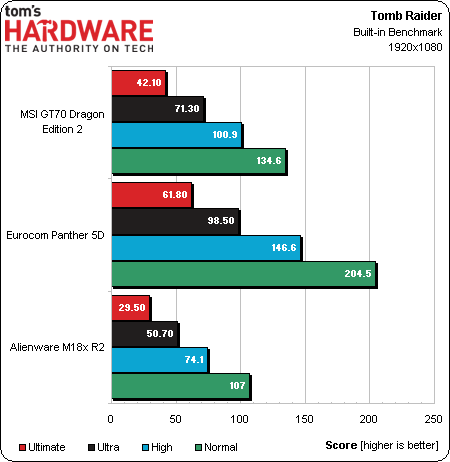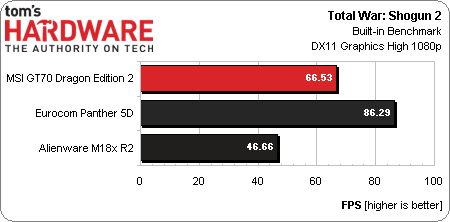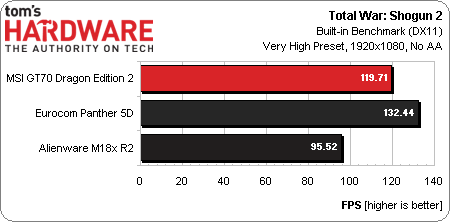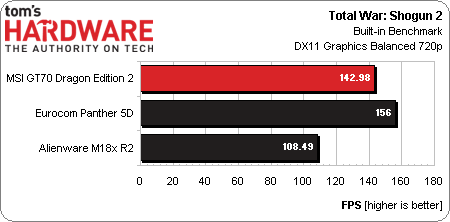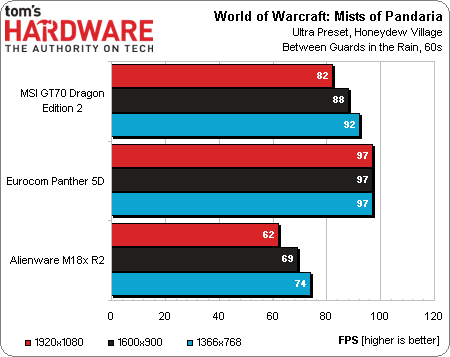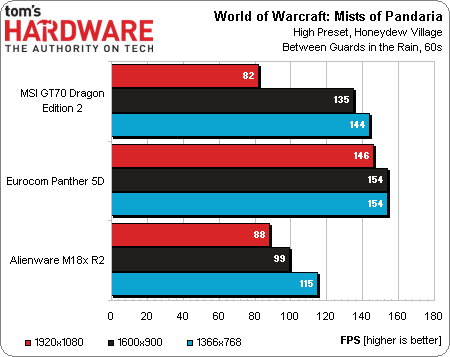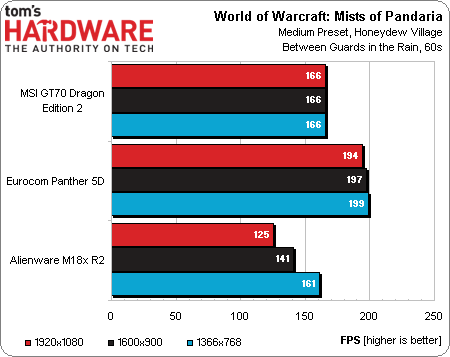MSI GT70 Dragon Edition 2 By Xotic PC: Haswell Goes Mobile
MSI's GT70 Dragon Edition 2 is in the lab, tuned up by Xotic PC. Sporting a Haswell-based mobile Core i7-4930MX CPU, Nvidia's GeForce GTX 780M, and a luxurious 17.3" FHD screen, this is one heavy-duty gaming notebook. At more than $3000, it should be.
Tomb Raider, Total War: Shogun 2, And WoW: Mists Of Pandaria
Tomb Raider
The built-in benchmark for Tomb Raider shows that the Alienware system's GeForce GTX 680M falls shy of delivering the 30 FPS average we're looking for. Meanwhile, the MSI’s overclocked GeForce GTX 780M manages a more comfortable 42 FPS, and the Eurocom Panther 5D leverages SLI to remain far ahead at every resolution.
Total War: Shogun 2
None of these machines have any problems playing Shogun 2 at its highest settings. What's more, we get a good sense of how the GeForce GTX 680M, 780M, and two 680Ms in SLI scale up.
Disabling anti-aliasing yields a massive performance increase.
This is largely an academic test, since the higher-resolution benchmark was plenty playable. However, dropping to 720p relieves enough of the graphics workload that MSI's GT70 almost catches Eurocom's more potent platform.
World Of Warcraft: Mist Of Pandaria
Get Tom's Hardware's best news and in-depth reviews, straight to your inbox.
World of Warcraft: Mists of Pandaria offers a lush expansion with detailed new worlds. One of the most demanding sections of the game is in Honeydew Village. Placing a character directly in-between the guards of the entrance to the city when it’s raining in-game, then panning the camera just above the grassy hill beside them brings a very high number of moving objects into view. It is one of the worst-case scenarios that we’ve found in the game.
There are a ton of moving components in our test sequence. Each machine delivers excellent frame rates, with only the Eurocom platform showing signs of an outright processor bottleneck.
The best-looking settings are plenty playable, so there's no real reason to drop to Blizzard's High preset. If you were to, however, performance would shoot up palpably.
It takes a GeForce GTX 780M to cause Intel's fastest Haswell-based mobile processor to show up as a bottleneck in this game. The lower-end GeForce GTX 680M in Alienware's M18x still scales paired to its Ivy Bridge-based CPU.
Current page: Tomb Raider, Total War: Shogun 2, And WoW: Mists Of Pandaria
Prev Page DiRT: Showdown, Hitman: Absolution, And Sniper Elite V2 Next Page Turbo Boost Behavior And Throttle Testing-
cobra5000 My A10 laptop w/7660g may not have the specs but it plays great and only cost me $505.99.Reply
How about that for bragging rights! -
sha7bot Forbes magazine posted a great article on this system, as well. Seems like Alienware, ASUS, and Clevo have some serious competition.Reply -
lunyone I have an AMD a6 quad core CPU w/7670 dGPU that cost me <$400 and it will game okay for most things. Of coarse it's no screamer unit, but for 95% of what I do it works just fine. Yes I would have loved to had a better system for light gaming, but my laptop fit my budget. I wish that we got off this 1366 x 768 resolution and started out at 1600 x 900 for 11-15" laptops as a minimum, but that is just me.Reply -
Ducktor Please remove the term W/h from the text as well as "Watt per hour" from the graph on page 14. This unit is meaningless! 1W = 1J/s which is already a rate of power consumption. Dividing this unit by an hour yields 1W/h = 1J/3600s^2 which actually implies an acceleration in power consumption! Such mistakes are really hard to accept on a technical site like Tom'sReply -
danwat1234 Yea, the 180w ac adapter in this laptop, and also in the Gt60-2od laptop (the 15" version of this laptop) should really come with a ~240w AC adapter like what the Asus G750 has, but it doesn't. So they made NOS to adapt.Reply
It is unfortunate. What if I want to crunch on the high-end CPU and the GPU 24/7 for some reason? Can't do it with a 180w AC adapter.
To those thinking that the built in single fan isn't good enough, it is a 12V fan! I have never seen a 12V fan in a laptop before but this one has it. The Coolerboost feature ramps up the fan RPM to maximum and really keeps the temperatures down.
There are some reports of bad paste jobs so if you are having high temps, that may be the reason. Call up MSI to verify that your warranty will not be void and then repaste it. MSI is cool in that they'll usually allow you to take off the heatsink whereas Asus won't.
Thanks Tom's for making a much better review than what Anand did!
So on page 14, the max power draw from the battery when the laptop is unplugged and you are gaming is only 85 watts? That must mean that the dedicated graphics is shut down and the HD4600 is only on? Can you have the 780m when on only battery power? -
luckiest charm I would feel awkward using this machine in trains, at relative's places, or anywhere else I can be spotted on so I don't become a laughing stock. :PReply -
custodian-1 With the problem with cell phones being stolen I would not take something out of the case.Reply -
boro169 I think it should be noted that derived notebooks from this like deviltechs are much cheaper. the starting point of msi is 2400 euros in my country and deviltechs modified msi cost me 2050 with a 250gb samsung 840 and a 1 tb 5400 hdd and the 780m.. yeah it doesn't have the steelseries keyboard it has de gt60 blue blaclight one but...Reply
for those talking about its not for hardcore gamers... I think they are wrong because i can't take my cosmos II tower with the 3930x and my titan on my back when i visit my girlfriend on train a 300km away from my home... and not everybody can have two of those beasts.. the desktop is always better but you can't drag it always with you to trips...
for the one talking about being scared of being robbed... I don't know why he walks on the streets wearing a wallet you COULD be robbed... or a plane could crash on your head.... ¬¬ then nobody would buy an smartphone. because to use it indoor and using outdoors and old nokia because if it is robbed its not an expensive lose....
if you at least talked about the processing power lose when not wall plugged or so that would be a reasonable comentary... -
warezme You know the new Haswell GTX780m Alienware models have been out for awhile. You should have done your comparison with one of those. LIkely more expensive but more direct comparison.Reply
